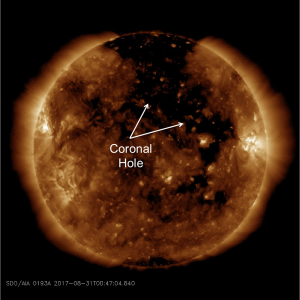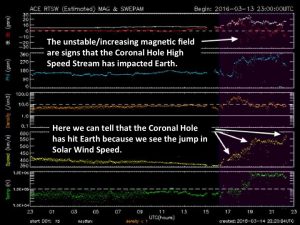
As Solar Minimum continues to approach, sunspots will become more scarce and so will coronal mass ejections. Most would assume that means solar activity will go quiet, but that is not the case. A solar feature called coronal holes will become the main focus for space weather enthusiasts and forecasters. With sunspot regions disappearing as solar minimum approaches, these dark regions on the Sun known as coronal holes will be the main driver of space weather. According to the Space Weather Prediction Center, coronal holes appear as dark regions on the Sun because they are cooler than the surrounding plasma and are open magnetic field lines. The Sun’s outermost part of its atmosphere, which is known as the corona, is where these dark regions appear. The solar corona was also one of the main features of the Sun scientists were most excited to study during the past solar eclipse. You are able to notice these features in extreme ultraviolet (EUV) and soft x-ray solar images.
Solar wind is always flowing from the Sun and towards Earth but coronal holes are known for releasing enhanced solar wind. Coronal holes can develop anywhere on the sun and are more common during solar minimum. One solar rotation of the Sun occurs every 27 days and coronal holes are sometimes able to last several of these. It is common to see persistent coronal holes at the north and south pole of the Sun but sometimes they can expand towards the equator of the Sun resulting in a larger region. Normally, coronal holes located near the Sun’s equator, result in faster solar wind arriving at Earth. It is common to see coronal holes produce G1-G2 geomagnetic storming levels and sometimes on rare occasions, upwards to G3 levels have been met.

NOAA forecasters analyze these features and have to take them into account during each forecast. If Earth is experiencing the effects of a coronal hole and a coronal mass ejection is forecasted to impact Earth, the combined effects could result in a more significant impact and more intense geomagnetic storming. Analyzing data from the DSCOVER and ACE satellite is one way forecasters can tell when the enhanced solar wind from a coronal hole is about to arrive at Earth. A few things they look for in the data to determine when the enhanced solar wind is arriving at Earth:
• Solar wind speed increases
• Temperature increases
• Particle density decreases
• Interplanetary magnetic field (IMF) strength increases
In coming years, scientists will get to learn more about coronal holes and the Sun’s corona where they originate. NASA’s Solar Probe Plus mission will be launching in 2018 and we’ll see the Sun like no spacecraft has ever seen before. At just 3.9 million miles away from the Sun during its closest approach, it’ll be the closest manmade object to ever orbit the Sun. According to NASA, the primary science goals for the mission are to trace the flow of energy and understand the heating of the solar corona and to explore what accelerates the solar wind. Combining this new data with our current EUV imaging satellites should allow forecasters to better predict the effects of these coronal holes and eliminate any uncertainties about this solar feature.
If you are an aurora chaser or space weather enthusiasts, you’ll want to become familiar with coronal holes. They will be providing much of our geomagnetic activity going forward and will remain persistent during solar minimum. Citizen Scientists should explore Aurorasaurus which allows you to share or get alerts and images on aurora activity with a community of others interested in space weather.